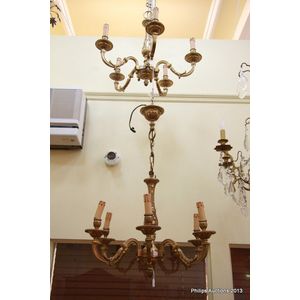Victorian Sterling Silver Cruet Set with Four Bottles
You must be a subscriber, and be logged in to view price and dealer details.
Subscribe Now to view actual auction price for this item
When you subscribe, you have the option of setting the currency in which to display prices to $Au, $US, $NZ or Stg.
- Engraving - The method of decorating or creating inscriptions on silver and other metal objects by marking the surface with a sharp instrument such as a diamond point or rotating cutting wheel.
- Embossed / Repousse - Embossing, also known as repousse, is the technique of decorating metal with raised designs, by pressing or beating out the design from the reverse side of the object.It is the opposite of chasing, where the decoration is applied from the front. An embossed or repoussed object may have chasing applied to finish off the design.
- Sterling Silver - Sterling silver is a mixture of 92.5% pure silver and 7.5% of another metal, usually copper. Fine silver is 99.9% pure silver, and is relatively soft and the addition of the very small amount of copper gives the metal enough strength and hardness to be worked into jewellery, decorative and household objects.
- Victorian Period - The Victorian period of furniture and decorative arts design covers the reign of Queen Victoria from 1837 to 1901. There was not one dominant style of furniture in the Victorian period. Designers used and modified many historical styles such as Gothic, Tudor, Elizabethan, English Rococo, Neoclassical and others, although use of some styles, such as English Rococo and Gothic tended to dominate the furniture manufacture of the period.
The Victorian period was preceded by the Regency and William IV periods, and followed by the Edwardian period, named for Edward VII (1841 ? 1910) who was King of the United Kingdom and the British Dominions and Emperor of India for the brief period from 1901 until his death in 1910.
This item has been included into following indexes:
Visually similar items

A pair of Louis XVI style gilt bronze and marble putti figured candelabra, 48 cm

Two bronze ceiling lights, circa 1950, in the neoclassical style, with restrained scrolls, foliate embellishments and pineapple finials, the six upward sweeping arms terminating in shallow brass bowls and electric candles. Length 84 cm. Diameter 63 cm

A pair of bronze and onyx candelabra, 19th century, in the Louis XV manner with a central knopped stem embellished with lions' heads and supporting five upward sweeping scrolled arms with bronze pans and dishes, upon a circular onyx socle and squared base

A pair of Louis XVI style gilt bronze chenets and fender, 19th century, each well cast as an urn topped pedestal with ram's head lug handles entwined with a sinuous arching snake motif, the acanthus leaf embellished pillar with paterae and pendant husks sw
